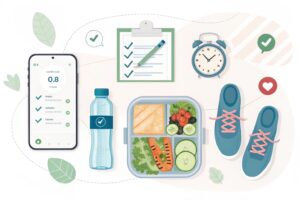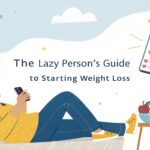Introduction
Small Changes, Big Results: Weight Loss for Absolute Beginners- Embarking on a weight‑loss journey can feel overwhelming, especially when you’re staring at a sea of fad diets and extreme training plans. The good news? You don’t need a complete lifestyle overhaul to see real progress. By focusing on small, sustainable adjustments—like swapping sugary drinks for water or adding a ten‑minute walk to your day—you can achieve big results without burnout. This guide breaks down the science, the psychology, and the practical steps that turn modest tweaks into lasting transformation, all while keeping the tone friendly, trustworthy, and expert‑backed.
Introduction
If you’ve ever wondered how to lose weight without turning your life upside‑down, you’ve landed in the right place. Small Changes, Big Results: Weight Loss for Absolute Beginners is a roadmap that shows you how incremental habits compound over weeks and months, delivering noticeable pounds off the scale and a healthier mindset. In the next sections, we’ll explore why tiny tweaks work, which micro‑behaviors have the highest impact, and how to design a personalized plan that respects your schedule, preferences, and medical background. Let’s dive in and prove that even beginners can achieve remarkable outcomes with the right approach.
Section 2 – Understanding the Foundations of Gradual Weight Loss
The Power of a Calorie Deficit, Explained Simply
Weight loss is fundamentally about creating a calorie deficit—burning more calories than you consume. While the math sounds straightforward, the human body is a complex system that responds to both energy balance and hormonal signals. Studies from the Harvard T.H. Chan School of Public Health reveal that a modest deficit of 250–500 kcal per day can lead to a safe, sustainable loss of 0.5–1 lb per week, which aligns with the CDC’s recommendation for long‑term health. Instead of drastic cuts, aim to shave off 100 kcal from two meals each day (e.g., swapping a regular soda for sparkling water, or choosing a smaller portion of rice). These micro‑adjustments add up without leaving you feeling deprived.
Why Small Habit Changes Outperform Mega‑Resolutions
Psychological research shows that behavioral momentum—the tendency to keep doing something once you’ve started—works best with low‑effort actions. A 2022 meta‑analysis in the Journal of Behavioral Medicine found that participants who introduced a single, easy habit (like a 5‑minute stretch routine) were 30 % more likely to stick with a broader weight‑loss program than those who launched with a full‑day workout schedule. Small wins boost confidence, reinforce identity (“I’m the kind of person who moves daily”), and reduce the cognitive load that often leads to abandonment. Think of each tiny habit as a building block; over 90 days, a series of 10‑minute walks, water‑first breakfasts, and mindful bites can create a compound effect akin to compound interest in finance.
Section 3 – Actionable Micro‑Changes That Deliver Real Results

1. Hydration as a Metabolic Accelerator
Start every morning with 16 oz (≈ 500 ml) of water before any food or coffee. Research published in Obesity Reviews (2020) indicates that drinking water before meals can cut calorie intake by up to 13 % in the short term. Additionally, staying hydrated supports optimal resting metabolic rate (RMR) and aids digestion. Keep a reusable bottle on your desk and set a gentle reminder on your phone to sip every hour.
2. Mindful Eating: The 20‑Second Pause
Before each bite, pause for 20 seconds to ask: Am I truly hungry? This simple check curtails emotional or distracted eating, a major contributor to excess calories. A randomized trial by University of Pennsylvania showed that participants who practiced a 30‑second pause before meals consumed 15 % fewer calories over 8 weeks. Pair the pause with a quick scan of the plate—aim for half vegetables, a quarter protein, and a quarter complex carbs—to reinforce balanced portions.
3. Micro‑Movement Throughout the Day
Incorporate 10‑minute “movement bursts” three times daily: a brisk walk after lunch, stair climbs during coffee breaks, or a quick bodyweight circuit while watching TV. The American Heart Association cites that intermittent activity boosts insulin sensitivity and improves cardiovascular health even if you don’t meet the classic 150‑minute weekly exercise guideline. Use a step counter or a smartwatch to log these bursts; the visible data will motivate you to keep the streak alive.
Section 4 – Comparing Traditional Diets with Incremental Approaches
Extreme Diets vs. Sustainable Adjustments
Crash diets (e.g., very low‑calorie or keto “quick fixes”) promise rapid loss but often lead to metabolic adaptation, where the body reduces its RMR to conserve energy—known as “starvation mode.” A 2021 review in Nutrients found that 70 % of participants on extreme diets regained the lost weight within a year, primarily due to unsustainable restrictions. In contrast, incremental changes preserve muscle mass, keep the metabolic rate stable, and are more enjoyable, leading to higher adherence rates (up to 80 % in longitudinal studies).
Benefits of Small‑Scale Habit Stacking
Habit stacking—pairing a new micro‑habit with an existing routine—creates cue‑behavior loops that are neurologically reinforced. For instance, after brushing your teeth (existing habit), drink a glass of water (new habit). This method taps into the brain’s basal ganglia, which is responsible for automatic behaviors, making the new habit less reliant on willpower. The Stanford Behavior Lab reports that habit stacking can accelerate habit formation by 30–50 % compared to isolated attempts.
Common Challenges and How to Overcome Them
-
- Impatience with Slow Progress – Set process goals (e.g., “Add a 5‑minute walk each day”) instead of outcome goals (“lose 10 lb in a month”).
-
- Social Pressure – Prep a few healthy snack options for gatherings; use the “portion swap” technique to enjoy favorites without excess calories.
-
- Plateau Effects – Rotate micro‑habits every 4–6 weeks (e.g., switch from water‑first breakfasts to adding a 5‑minute core routine) to keep the body adapting and prevent stagnation.
Section 5 – Practical Tools, Resources, and a Step‑by‑Step Guide

Step 1: Baseline Assessment (Day 1‑3)
-
- Track your food using a free app like MyFitnessPal for three consecutive days (including one weekend day) to gauge average calorie intake.
-
- Measure activity with a phone pedometer; note daily steps and sedentary hours.
-
- Record weight and waist circumference—the numbers serve as reference points, not daily targets.
Step 2: Choose Three “Micro‑Focus Areas”
Select the most impactful tweaks based on your baseline:
-
- Hydration – Add a water bottle to your bag.
-
- Movement – Schedule three 10‑minute walks.
-
- Mindful Eating – Implement the 20‑second pause before meals.
Set SMART (Specific, Measurable, Achievable, Relevant, Time‑bound) mini‑goals, such as “Drink two extra glasses of water before lunch for the next 14 days.”
Step 3: Implement, Review, Adjust (Weeks 1‑4)
-
- Use a simple habit tracker (paper calendar or digital app like Habitica) to mark daily completion.
-
- At the end of each week, review: Did you meet the water goal? How did the extra walks feel? Adjust the difficulty if needed (e.g., increase walk duration to 15 minutes).
-
- Celebrate small victories—share a post on social media or reward yourself with a non‑food treat (new workout socks, a relaxing bath).
Bonus Tools for Long‑Term Success
-
- Sleep Tracker (e.g., Fitbit) – Adequate sleep improves leptin and ghrelin balance, crucial for appetite regulation.
-
- Meal‑Prep Templates – Spend Sunday prepping protein portions (chicken, beans) and pre‑cut veggies for quick assembly.
-
- Community Support – Join a beginner‑friendly forum like Reddit’s r/loseit or a local walking group to stay accountable.
Section 6 – Frequently Asked Questions, Final Thoughts, and CTA
FAQ 1: Will I see weight loss if I only change my diet but not exercise?
Yes. Creating a modest calorie deficit through dietary tweaks alone can produce weight loss. However, adding micro‑movement accelerates fat loss, preserves lean muscle, and improves cardiovascular health, making results more pronounced and sustainable.
FAQ 2: How long does it take for small changes to show results?
Most individuals notice subtle shifts—like increased energy, reduced bloating, or a 1–2 lb loss—within 2–4 weeks of consistent habit implementation. Remember that consistency trumps speed; the goal is to build habits that last months and years.
FAQ 3: What if I have a medical condition (e.g., thyroid, diabetes)?
Consult your healthcare provider before initiating any weight‑loss plan. Many small changes—like drinking more water, walking, or mindful eating—are generally safe, but personalized guidance ensures you stay within appropriate limits and medication adjustments if needed.
Closing Thoughts
Small, intentional tweaks are the secret sauce behind big, lasting weight‑loss results for absolute beginners. By focusing on hydration, mindful eating, and micro‑movement, you lay a solid foundation that the science backs and everyday life supports. Remember, the journey is a marathon, not a sprint—celebrate incremental victories and let them compound into a healthier, happier you.
Ready to start? Grab a water bottle, set a 10‑minute walk on your calendar, and pause before your next bite. Share your first micro‑habit in the comments below, invite a friend to join, and explore related posts like “10 Easy Breakfast Swaps for Fat Loss” and “How to Use a Step Counter for Weight Management.” Together, we’ll turn small changes into big results—one day at a time.


